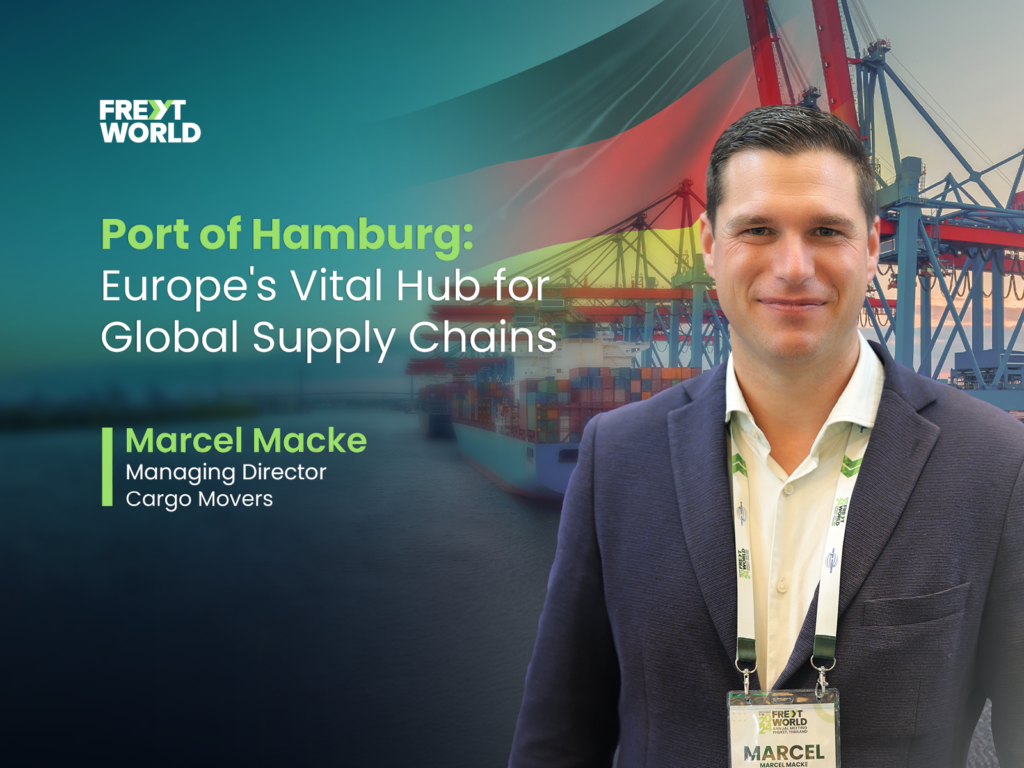By Marcel Macke, Managing Director of Cargo Movers in Germany

The Strategic Importance in European Logistics Supply Chain
The Port of Hamburg, one of Europe's most important seaports, and the third-largest container hub, plays a pivotal role in the continent's logistics and supply chain networks. As Germany's largest port and a leading international hub, it serves as a critical gateway and enhances connectivity within the global economy.
This strategic facility handles approximately 8.7 million TEUs (twenty-foot equivalent units) annually, demonstrating its massive capacity and operational scale. The port's influence extends throughout Northern Europe, with trade connections reaching into Scandinavia, the Baltic states, and Central European nations. Its economic impact generates over €21.8 billion in added value for the German economy and supports approximately 165,000 jobs nationwide.
The port's central location within the European transport network makes it an essential part of Europe's multimodal logistics system, connecting sea, rail, and road transport in an integrated manner. This integration creates seamless transitions between transport modes, reducing delays and enhancing efficiency. The port's rail infrastructure includes over 300 kilometers of tracks and connects to Germany's extensive rail network, allowing for direct distribution to major economic centers. More than 200 freight trains depart Hamburg daily, carrying goods to destinations throughout Europe. This rail connectivity reduces road congestion and lowers the carbon footprint of transported goods.
Container Shipping Excellence in the European Logistics Supply Chain
The Port of Hamburg is particularly significant in the context of container shipping. It serves as a primary hub for containerized goods moving between Europe and major global markets, such as Asia, North America, and Africa. With its highly efficient logistics services, the port ensures that goods are moved quickly and reliably, supporting the global supply chain and enhancing Europe's competitiveness in international trade. To handle rising volumes, Hamburg is prioritizing terminal automation. The Container Terminal Altenwerder (CTA) now operates in automation, using AI-powered cranes to reduce vessel turnaround times (Port of Hamburg Authority, 2024).
The automated systems at CTA represent the cutting edge of port technology. These systems can operate 24/7 with minimal human intervention, dramatically improving throughput capacity. The automated guided vehicles (AGVs) transport containers between ship-to-shore cranes and the storage yard, following optimized routes calculated by central logistics software. This automation has increased productivity by approximately 30% compared to conventional terminals while reducing operating costs and human error.
The port has invested over €2 billion in infrastructure improvements over the past decade. These investments include deeper navigation channels to accommodate ultra-large container vessels (ULCVs), expanded terminal facilities, and enhanced hinterland connections. The Elbe River fairway has been deepened to allow ships with a draft of up to 14.5 meters to reach the port terminals, ensuring Hamburg remains competitive for the largest container vessels in operation.
Digital Transformation and Information Management
The digital transformation of Hamburg's port operations extends beyond physical automation. The Port Community System provides a unified digital platform that connects all stakeholders in the logistics chain. This system processes over 3,000 vessel calls annually and manages documentation for millions of containers. Real-time data sharing between shipping lines, terminal operators, customs authorities, and inland carriers reduces administrative delays and improves planning accuracy.
Advanced analytics and artificial intelligence applications help predict vessel arrivals, optimize berth allocations, and forecast cargo volumes. These predictive capabilities enable proactive resource allocation and capacity planning. The port's commitment to digitalization has reduced average container dwell times by 15% and improved overall operational resilience during disruptions like the COVID-19 pandemic.
Sustainability Initiatives Across the European Logistics Supply Chain
The Port of Hamburg is also focused on sustainability and innovation. With a commitment to reducing environmental impact, the port has invested in green technologies, such as renewable energy, eco-friendly cargo handling systems, and alternative fuel options for vessels. These efforts align with the European Union's broader goals of reducing carbon emissions and promoting sustainable development in logistics and transportation. Hamburg's "Green Port 2030" initiative aims to cut emissions via shore-side electricity for vessels and hydrogen-powered terminal equipment.
Environmental monitoring stations throughout the port area continuously measure air quality, water quality, and noise levels. This data informs targeted improvement initiatives and enables transparent reporting of environmental performance. The port authority has implemented strict environmental standards for vessels entering Hamburg waters, with preferential treatment and reduced fees for ships meeting advanced emissions criteria.
The port's comprehensive environmental strategy includes biodiversity protection measures for the sensitive Elbe River ecosystem. Habitat conservation projects, water quality management programs, and careful dredging practices minimize the ecological impact of port operations. These environmental protection measures demonstrate Hamburg's commitment to responsible growth that balances economic and ecological considerations.
Infrastructure Development and Future Planning
The Hamburg Port Authority has developed a master plan extending to 2040, outlining future infrastructure developments and strategic priorities. This plan includes further terminal automation, continued channel deepening, and enhanced multimodal connections. The authority works closely with city planners to ensure port development integrates harmoniously with urban growth and addresses community concerns.
Land use optimization represents a key challenge for Hamburg's future. With limited space for expansion, the port focuses on increasing efficiency within its existing footprint. Vertical storage solutions, densification of operations, and repurposing of underutilized areas help maximize capacity without geographical expansion. These space optimization strategies will be critical as cargo volumes continue to grow in the coming decades.
Economic Impact Beyond Germany's Borders
The Port of Hamburg's economic influence extends throughout the European continent. As a primary gateway for Asian imports, it supplies retailers and manufacturers across Northern and Central Europe with essential goods and components. The port processes approximately 9.3 million tons of agricultural products annually, supporting Europe's food supply chains and export markets for European producers.
The port functions as an economic multiplier, with each euro of direct port activity generating an additional €1.7 in related economic activity. This multiplier effect benefits logistics providers, transportation companies, warehousing operations, and various service industries. More than 1,000 logistics companies operate in the Hamburg metropolitan area, forming a dense network of specialized expertise that enhances the region's competitive advantage.
Hamburg's Role in Reshaping the European Logistics Supply Chain
The Port of Hamburg actively influences the evolution of European logistics networks through strategic partnerships and collaborative initiatives. It participates in the European Union's TEN-T (Trans-European Transport Network) program, which aims to strengthen connectivity between European transport hubs. These collaborative efforts improve coordination between ports, reduce bottlenecks, and enhance the resilience of European supply chains.
Innovation partnerships between the port, research institutions, and technology companies drive continuous improvement in logistics practices. The Hamburg Port Authority supports startups and technology pilots that address specific logistics challenges. This innovation ecosystem ensures Hamburg remains at the forefront of logistics technology development and implementation.
A Foundation for European Economic Competitiveness
The Port of Hamburg is more than just a physical location—it is an integral component of the European logistics ecosystem. Its advanced infrastructure, strategic location, and commitment to innovation ensure that it remains a key player in the global supply chain, driving economic growth and facilitating efficient trade across Europe and beyond.
Hamburg's continued evolution demonstrates how traditional maritime infrastructure can adapt to modern requirements and future challenges. By embracing digitalization, sustainability, and connectivity, the port provides a model for logistics hubs worldwide. Its success shows the critical role efficient ports play in supporting economic prosperity and maintaining global competitiveness.
As trade patterns evolve, Hamburg's adaptability and vision position it as a cornerstone of European logistics. The port's balance of operational excellence, environmental responsibility, and innovation ensures its importance in connecting European businesses globally. Through ongoing efforts, the Port of Hamburg strengthens Europe's position in trade and supports economic development across the continent.

Freyt World Blog Contributor
Freyt World is a global logistics network uniting members from around the world. Our mission is to revolutionize global logistics through collaboration and innovation. Our platform goes beyond networking, enabling members to excel and grow together, featuring articles by logistics professionals for their peers. This series will cover industry-relevant issues and news, providing valuable insights for professionals in the field.